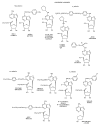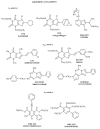Adenosine and ischemic preconditioning
- PMID: 10607860
- PMCID: PMC3561763
Adenosine and ischemic preconditioning
Abstract
Adenosine is released in large amounts during myocardial ischemia and is capable of exerting potent cardioprotective effects in the heart. Although these observations on adenosine have been known for a long time, how adenosine acts to achieve its anti-ischemic effect remains incompletely understood. However, recent advances on the chemistry and pharmacology of adenosine receptor ligands have provided important and novel information on the function of adenosine receptor subtypes in the cardiovascular system. The development of model systems for the cardiac actions of adenosine has yielded important insights into its mechanism of action and have begun to elucidate the sequence of signalling events from receptor activation to the actual exertion of its cardioprotective effect. The present review will focus on the adenosine receptors that mediate the potent anti-ischemic effect of adenosine, new ligands at the receptors, potential molecular signalling mechanisms downstream of the receptor, mediators for cardioprotection, and possible clinical applications in cardiovascular disorders.
Figures




Similar articles
-
Adenosine A1 and A3 Receptors: Distinct Cardioprotection.Drug Dev Res. 2001 Jan-Feb;52(1-2):366-378. doi: 10.1002/ddr.1136. Drug Dev Res. 2001. PMID: 39741902 Free PMC article.
-
A physiological role of the adenosine A3 receptor: sustained cardioprotection.Proc Natl Acad Sci U S A. 1998 Jun 9;95(12):6995-9. doi: 10.1073/pnas.95.12.6995. Proc Natl Acad Sci U S A. 1998. PMID: 9618527 Free PMC article.
-
Sites of action of adenosine in interorgan preconditioning of the heart.Am J Physiol Heart Circ Physiol. 2002 Jul;283(1):H29-37. doi: 10.1152/ajpheart.01031.2001. Am J Physiol Heart Circ Physiol. 2002. PMID: 12063271
-
Adenosine in myocardial protection in on-pump and off-pump cardiac surgery.Ann Thorac Surg. 2003 Feb;75(2):S691-9. doi: 10.1016/s0003-4975(02)04694-5. Ann Thorac Surg. 2003. PMID: 12607714 Review.
-
Ischemic preconditioning.Curr Opin Cardiol. 1997 Sep;12(5):475-81. Curr Opin Cardiol. 1997. PMID: 9352175 Review.
Cited by
-
Cell type-specific effects of adenosine on cortical neurons.Cereb Cortex. 2015 Mar;25(3):772-87. doi: 10.1093/cercor/bht274. Epub 2013 Oct 9. Cereb Cortex. 2015. PMID: 24108800 Free PMC article.
-
Exploring human adenosine A3 receptor complementarity and activity for adenosine analogues modified in the ribose and purine moiety.Bioorg Med Chem. 2005 Feb 15;13(4):973-83. doi: 10.1016/j.bmc.2004.11.044. Bioorg Med Chem. 2005. PMID: 15670905 Free PMC article.
-
Contribution of extrasynaptic N-methyl-D-aspartate and adenosine A1 receptors in the generation of dendritic glutamate-mediated plateau potentials.Philos Trans R Soc Lond B Biol Sci. 2015 Jul 5;370(1672):20140193. doi: 10.1098/rstb.2014.0193. Philos Trans R Soc Lond B Biol Sci. 2015. PMID: 26009772 Free PMC article.
-
Adenosine A3 Receptor: From Molecular Signaling to Therapeutic Strategies for Heart Diseases.Int J Mol Sci. 2024 May 25;25(11):5763. doi: 10.3390/ijms25115763. Int J Mol Sci. 2024. PMID: 38891948 Free PMC article. Review.
-
Synthetic Small-Molecule Ligands Targeted to Adenosine Receptors: Is There Potential Towards Ischemic Heart Disease?Cells. 2025 Aug 7;14(15):1219. doi: 10.3390/cells14151219. Cells. 2025. PMID: 40801651 Free PMC article. Review.
References
-
- Linden J, Jacobson KA. In: Cardiovascular Biology of Purines. Burnstock Geoffrey, Dobson James G, Liang Bruce T, Linden Joel., editors. Kluwer Academic Publishers; Dordrecht/Boston/London: 1998. pp. 1–20.
-
- Stiles GL. J Biol Chem. 1992;267:6451. - PubMed
-
- Mathern GP, Headrick JP, Liang BT. In: Cardiovascular Biology of Purines. Burnstock Geoffrey, Dobson James G, Liang Bruce T, Linden Joel., editors. Kluwer Academic Publishers; Dordrecht/Boston/London: 1998. pp. 65–85.
-
- Liang BT. Trends in Cardiovascular Medicine. 1992;2:100. - PubMed
-
- Parsons M, Musikabhumma P, Jacobson KA, Liang BT. Circ (suppl) 1998;98:2196.
Publication types
MeSH terms
Substances
Grants and funding
LinkOut - more resources
Full Text Sources
